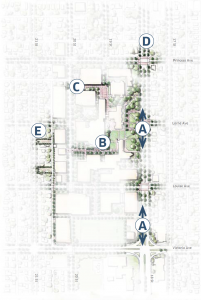Quick Win Initiatives
The following priority projects are considered immediate “low hanging” opportunities for improvements that do not require excessive groundwork or fiscal allowances. They should take place before the official first phase of development, and are simple yet effective steps towards revitalization. Most of the initiatives identified include landscape interventions that would increase the visibility, permeability, and accessibility of the Campus; make the campus feel more safe and pedestrian friendly; increase the use of the open spaces; and initiate TDM strategies to start shifting the modal split from predominantly single occupant vehicular use.
(A) East Campus Edge Landscapes
The formal front landscapes fronting 18th Avenue can be enhanced with minimal cost to the University and would have a high degree of impact on improving the Campus. The overgrown hedges and landscaping fronting 18th Street and the landscaping at the corner of Victoria Avenue create an obstruction to sight-lines and prohibit physical access from one of the most trafficked roads into the Campus.
Recommendations:
- Remove the hedges and carefully limb up the mature evergreen trees to help create a more open and inviting environment along the street that grants the surrounding neighbourhood and passers-by visual and physical connectivity to the University.
- Remove the fence around the open space area to make the space and the Campus more inviting to the community.
- The landscape at the corner of Victoria Avenue and 18th Street should be maintained as a useable passive open space in the short term. Enhancements should include removal of the rocks, maintenance of the trees by either the University or a certified arborist.
- Consider the integration of a significant art piece at the corner of Victoria Avenue and 18th Street.
(B) Enhancing the Campus Quad
The transformation of the Quad into a primary central gathering space, provides the opportunity to create a significant open space in the short term, that can be animated year-round.
Recommendations:
- Remove the Lot 1 parking adjacent to the Student Union Centre and replace with open lawn to expand the existing quad space. Consider design of the open lawn to accommodate a skating area during the winter months.
- Consider removal of the storage building adjacent to the Student Union Centre in the short term to further enhance the Quad.
- Vehicular access other than to service the area, should be limited and priority given to pedestrian and bicycle circulation.
- Existing evergreen trees within the quad space should be limbed up to a minimum of eight feet from the ground to allow for clear passage, visibility, and use of space under the trees.
- The University should engage a certified arborist to prune the mature trees on the Campus.
(C) Enhancing the Internal Service Road – the A. E. McKenzie Plaza
Re-paving the internal service roads, called the A. E. McKenzie Plaza in this document, to significantly enhance the pedestrian realm of the Campus. This is the space between the Music Building and the Education Building.
Recommendations:
- Enhance the service corridor with unit pavers to create an internal plaza space that is more inviting and pedestrian friendly.
- Screen garbage storage areas and utility boxes with fencing and landscaping.
(D) Improving Crossings & Signalization Along 18th Street
Safe pedestrian crossings to the Campus are limited, especially for the majority of students that come from the east side who have to cross 18th Street. A quick and low-cost approach, to be undertaken by the City, is to re-paint existing crosswalks with highly visible markings, and revisit and refine the timing of vehicular signalization at the intersections to allow for safer crossing of the street.
Recommendations:
- Initiate conversations with the City and Manitoba Infrastructure and Transportation (MIT) regarding developing a strategy for the pedestrianization of the portion of the roadways that front the University.
- Encourage the City to implement high visibility crosswalk painting and potentially enhanced paving materials at the intersections to increase visibility of the pedestrian crossings.
- Encourage the City to initiate a transportation signalization review regarding the timing of lights at the intersections to allow for safer pedestrian crossing of the street.
- Encourage the City to improve the walkability and beautification of the streets by initiating a Streetscape Master Plan for the portion of street and avenue fronting the University.
(E) Enhancing the West Parking Lots and Laneway
The parking lots in the west campus area, including the small lots within the residential blocks, should be enhanced to provide an improved interface to the community and along 20th Street. The adjacent laneway that services both the residences and the University should also be enhanced.
Recommendations:
- Consider improving the pavement surface treatment to create a more formalized and attractive surface parking area. Consider using sustainable (permeable) surface materials such as Turf Stone or permeable asphalt.
- Define the edges of the parking lots with attractive landscaping, and signage and lighting to improve wayfinding and pedestrian safety.
- Maintain the laneway as a useable pedestrian and cycling corridor. Consider upgrading to concrete as a surface paving treatment and provide lighting to enable safe circulation.
(F) Transportation Demand management (TDM) Strategies
The University already undertakes some TDM strategies and should continue to do so while exploring opportunities to be more aggressive with these strategies.
Recommendations:
- Manage parking demand through pricing and parking passes.
- Provide cycling infrastructure, including an increased amount of bike parking posts or racks, as well as location(s) for sheltered bike parking and shower and change room facilities for cyclists.
- Program events around TDM awareness and opportunities offered on campus.

